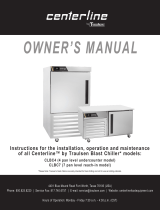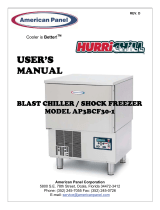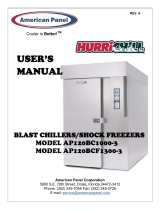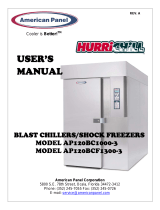
IV. CARE & MAINTENANCE
-6-
IV. a -
CLEANING THE CONDENSER:
The most important thing you can do to insure a long,
reliable service life for your Traulsen is to regularly
clean the condenser coil. The self-contained condens-
ing unit requires regularly scheduled cleaning to keep
the finned condenser clean of lint and dust accumula-
tion. Keeping the condenser clean allows the cabinet
to operate more efficiently and use less energy.
To clean the self-contained condenser, first discon-
nect electrical power to the cabinet and lift up the front
louver assembly. To lift this, remove the two thumb
screws located on both sides at the bottom of the lou-
ver assembly. Once the screws are removed, the panel
can be pivoted upwards allowing full access to the
front facing condenser (for model RBC50, remove the
four Phillips head screws from the front louver panel,
and lift-off). Vacuum or brush any dirt, lint or dust
from the finned condenser coil, the compressor and
other cooling system parts. If significant dirt is clog-
ging the condenser fins, use compressed air to blow
this clear. Lower louver assembly and replace thumb
screws to hold it in place. For care of the remote con-
densing unit(s) used for models RBC200, RBC200RT,
RBC400 and RBC400RT, consult the manufacturer’s
product literature.
IV. b -
CLEANING THE EXTERIOR:
Exterior stainless steel should be cleaned with warm
water, mild soap and a soft cloth. Apply with a damp-
ened cloth and wipe in the direction of the metal grain.
Avoid the use of strong detergents and gritty, abra-
sive cleaners as they may tend to mar and scratch the
surface. Do NOT use cleansers containing chlorine,
this may promote corrosion of the stainless steel.
Care should also be taken to avoid splashing the unit
with water, containing chlorinated cleansers, when
mopping the floor around the unit. For stubborn odor
spills, use baking soda and water (mixed to a 1 TBSP
baking soda to 1 pint water ratio).
WARNING: DISCONNECT ELECTRICAL POWER
SUPPLY BEFORE CLEANING ANY PARTS OF THE
UNIT.
IV. c - CLEANING THE INTERIOR:
For cleaning stainless steel interiors, the use of bak-
ing soda as described in section “IV. b” is recom-
mended. Use on breaker strips as well as door gas-
kets. All interior fittings are removable without tools
to facilitate cleaning. A defrost cycle is the ideal time
for performing interior cleaning.
IV. d - INSTALLING PRINTER PAPER:
Remove the two (2) thumb screws on either side of
the printer cover. Pull the printer cover out and up to
expose the printer. Cut a clean edge on the end of a
roll of printer paper. Install the printer paper in through
V. a - SERVICE AGENCY CHECK & START-UP:
After installation and start-up, contact Traulsen’s Ser-
vice Department at (800) 825-8220 to arrange for a
“Mechanical Installation and Operation Inspection,”
which is required by Traulsen to validate the warranty.
On-site inspection not required for model RBC50.
V. b - ON-SITE BLAST CHILL TRAINING:
Traulsen offers the operator comprehensive one and
two day, on-site training in the proper operation of
your Blast Chiller. Contact your authorized Traulsen
equipment dealer for more information.
V. c - SERVICE INFORMATION:
Before calling for service, please check the follow-
ing:
Is the electrical cord plugged in?
Is the fuse OK or circuit breaker on?
If after checking the above items and the unit is still
not operating properly, please contact an authorized
IV. d - INSTALLING PRINTER PAPER (cont’d):
the paper opening with the spindle in the paper roll.
Position the paper so it is fed out from the bottom of
the roll. Feed the paper into the bottom of the printer
enough to start the edge of the paper and press the
print button on the key pad (this will draw the paper
up through the printer and feed the paper out through
the front of the printer).
Feed the printer paper through the slot in the printer
cover and position the printer cover in place. Secure
the printer cover with the original screws (see figure
11).
Test the printer by pressing the print button and make
sure the paper feeds normally and the text is clear.
Printer paper is standard 2-1/4” wide x 100’ long “small
diameter,” Office Depot #451 - 310. Printer ribbon
Traulsen service part number SPR-00001-00 is Epson
#ERC-09, or Office Depot #626-602.
Fig. 11
2-14” wide
x 100’ long
“small
diameter”
paper roll
V. OTHER
























